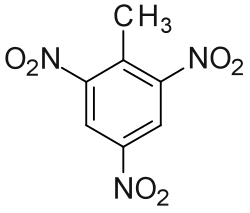Trinitrotoluene
impact-resistant high explosive From Wikipedia, the free encyclopedia
Trinitrotoluene (abbreviated TNT) (/ˌtraɪˌnaɪtroʊˈtɒljuiːn/) more specifically 2,4,6-trinitrotoluene, is a powerful nitroaromatic explosive, occasionally used as a reagent in chemical synthesis.

History
TNT was first made in 1863 by Julius Wilbrand[1] and originally used as a yellow dye. It was not recognized as an explosive for 28 years, until the chemist Carl Häussermann discovered its explosive properties in 1891.[2]

The German military started filling artillery shells with TNT 1902. TNT-filled shells would explode after they had broken through the armour of ships, whereas the British Lyddite (Picric acid)-filled shells exploded when they hit the armour, wasting energy outside the ship.[3] The British started replacing Pciric acid with TNT in 1907.[4]
Uses
TNT is one of the world's most commonly used explosives, in the military, mining, and industrial operations.
TNT is often blended with other explosives to get desired properties.[source?]
References
Wikiwand - on
Seamless Wikipedia browsing. On steroids.
